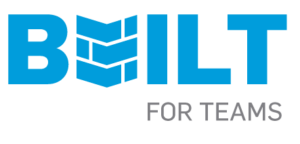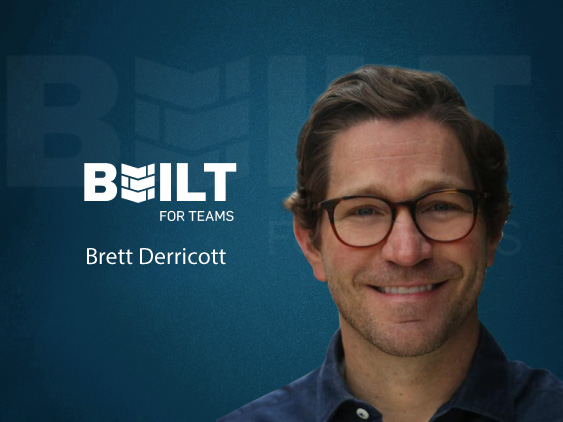Brett Derricott, Founder and CEO at Built for Teams joins us in this quick QnA interview to discuss his journey as a serial entrepreneur while also sharing his insights and tips on HR Tech best practices.
Can you tell us about yourself and your journey so far? What inspired you to start Built for Teams?
I have always had a passion for the intersection between creativity and technology. When I discovered software development in college, something clicked. I loved the speed and freedom of coding, and that interest has stuck with me ever since. After I graduated, I spent a few years working as a developer and went on to start my first company. Now, nearly 20 years later, whenever I see a piece of software, my first thoughts are how does it work and how could I make it better.
Built for Teams was entirely the product of that drive and interest. There are so many common HR problems and complaints that can be fixed or mitigated with technology. If I can create a product that makes the lives of HR professionals easier, why not do it? From there it was just a question of identifying the biggest problem areas and designing a platform that could solve them.
What are the key pain points and challenges that Built for Teams help solve?
When you’re starting a company, you often don’t consider your management structure, your five-year plan, or the professional development of your employees; you’re just trying to make it to next week. It takes a lot of factors, like time and expertise, to guide a company through growth and change. When I started my own companies, I quickly discovered I had to be a CEO, an accountant, a head of HR, the lead salesman, etc. Every second I spent doing a task that could be accomplished with technology was a moment I wasn’t being strategic or creative.
Built for Teams fixes that issue and frees up internal capacity with automated processes that help manage HR. Our two major products, organizational charts and PTO tracking, are both designed to tackle a specific problem our customers have repeatedly encountered. PTO tracking is a tactical, everyday tool that keeps PTO requests and management off the desks of HR professionals, freeing up their time to focus on strategy. Our organizational charts help companies grow, plan, and more effectively manage their employees by limiting the number of direct reports, assisting with succession and advancement planning, and creating a comprehensive roster of employees, their backgrounds, and their skill sets.
Recommended: TecHR Interview with Ian Cook, VP of People Solutions at Visier
Can you talk about some innovative/unique examples of how top tech teams are using HR Tech tools to UP their people management / recruiting game?
C3.ai is a dynamic, growing company that develops enterprise AI solutions (artificial intelligence products that help companies run their operations more effectively). Unfortunately, they encountered a common challenge for any rapidly growing company—tracking an organizational structure and who fills what role. The decision-makers at C3.ai made a choice. They wanted more out of their organizational structure. Rather than trying to keep up with a static org chart and spreadsheets, they contracted Built for Teams. With our platform, they opened the door to advanced workforce planning capabilities and now have immediate, up-to-date access to critical organization metrics including open positions, manager to employee ratios, and more.
What are some of the biggest challenges you see HR teams face when it comes to choosing and implementing an HR tech stack?
Choosing the right HR tech stack is too often done by decision-makers who are removed from the problems and needs of an organization. I’ve seen executives mandate the choice of an HR platform because they believe it can solve all of HR’s issues, even when the HR team knows the product has flaws and there are options on the market that fit their organization’s specific needs. The solution is simple and universal: before you buy a tool for your employees, ask them what they need it to accomplish and see if they have any recommendations. They are the ones who will ultimately use it every day—you want them to like it.
Can you share some best practices when it comes to “choosing the right HR Tech tool” – what should teams keep in mind?
Since I started Built for Teams, I’ve learned one lesson: companies should prioritize ease of use above all else. It doesn’t matter how much money was saved or how nice it is to have a single HR vendor if your employees won’t use the product. A lot of our customers are companies who first tried a product that was cheap or was free from their payroll vendor. Before choosing any HR tech tool, a company should find out what real users think about the product’s ease-of-use. Dig around online, ask your employees, and connect with other businesses you’re friendly with to get their recommendations.
What are the top factors teams should keep in mind when it comes to integrating their HR tool with other marketing/sales products within the organization?
It’s becoming more common for HR tools to be compatible and integrate with one another. That is great news for companies. This makes it possible to choose the best product for each specific HR need, rather than accepting the mediocre aspects of an all-in-one platform.
Recommended: TecHR Interview with Przemek Berendt, Founder of Talent Alpha
What’s your smartest productivity hack?
I’m a big fan of using mind mapping to organize and prioritize tasks for the day. Traditional to-do lists are great, but as my days have gotten increasingly complex I’ve needed to be able to visualize my action items across many categories and levels of priority. Drawing a mind map helps me better visualize how tasks relate and then identify a plan of attack.
What is your biggest learning so far in HR Tech?
As often as that message is pushed by marketing teams at hundreds of companies, a single product can’t adequately solve all the common problems of HR. I would encourage any company looking to adopt a new platform to explore multiple products and companies, and then figure out which ones offer the best solution for each individual need. Don’t just accept mediocrity; take charge of your problems.
What is your favorite HR quote?
Leadership is the art of getting someone else to do something you want done because he wants to do it. —President Dwight D. Eisenhower
I think all business leaders should take this approach. People will always be more motivated when they are working towards a goal they believe in and want to reach, rather than just following orders.
Thank you, Brett! This interaction was fun and hope to see you back on TecHRSeries soon.
Also Read: TecHR Interview with Doug Dennerline, CEO at Betterworks

Built for Teams creates modern, well-designed tools that help company leaders better understand and manage their most valued resource: their people. Our flagship product is our PTO Tracker, which works alongside existing payroll systems to add robust, automated processes for accruals, requests, approvals, and employee self-service access. Our Org Chart product is especially helpful for mid to large organizations looking for a better way to do workforce planning. As we continue to develop innovative solutions our HR Suite continues to grow and become more comprehensive, while maintaining our characteristic ease of use and visual appeal.
Brett Derricott is a serial entrepreneur, software expert, and angel investor. He is the founder and CEO of Built for Teams, an HR intelligence platform that helps business leaders understand, manage, and grow their human capital. He’s been recognized by Utah Business Magazine’s Forty under 40 for his business acumen.

